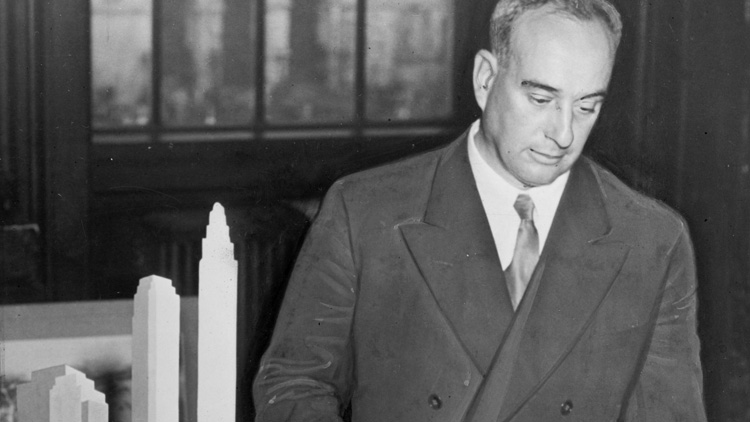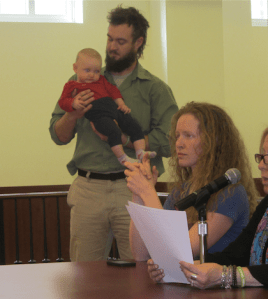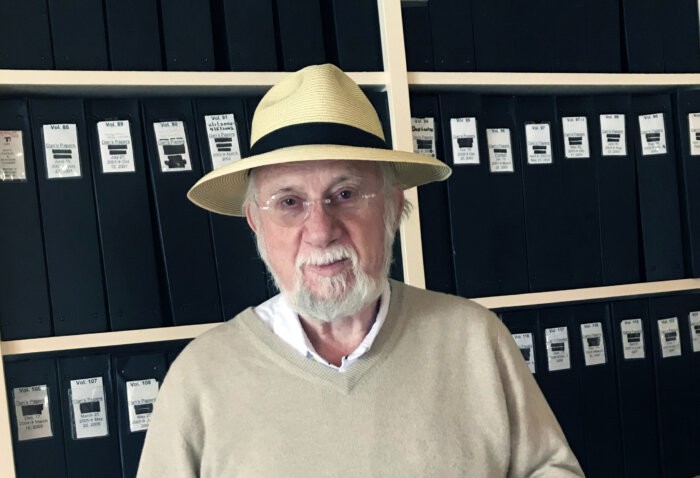The one person who did more than any other human being to shape the future of Long Island was born in Connecticut on Dec. 18, 1888, and died at Good Samaritan Hospital in West Islip in 1981. Robert Moses never got a driver’s license but Long Islanders would get nowhere fast without his roads today—even though his Northern Parkway and the Southern State have long been obsolete. He regarded Nassau and Suffolk as the state’s playgrounds for New York City’s middle-class whites but without his vision for open space, there’d be far fewer parks here bigger than a village green. He never held elected office yet he wielded an unprecedented amount of political power.
“If there wasn’t a Moses, New York State and Long Island would be a far poorer place,” says Dr. Lee Koppelman, Suffolk County’s former master planner and the director of Stony Brook University’s Center for Regional Policy Studies, where he still teaches. “There will never be another one in the State of New York—the politicians wouldn’t tolerate it.”
Moses was full of contradictions: a builder, a bigot, a reformer, a bully, a social engineer, a misanthrope, and, without a doubt, a genius. Robert Caro, the former Newsday reporter who wrote the masterful 1974 Pulitzer-Prize-winning biography, The Power Broker: Robert Moses and the Fall of New York, called him “a dreamer,” “a very courageous idealist” and “a visionary” who could all too easily overlook “the human cost” of his projects. In his monumental book, Caro depicted Moses’ heartless destruction of a Bronx neighborhood, East Tremont, to make way for the Cross-Bronx Expressway, his callous disregard of Suffolk farmers shoved aside to accommodate the Northern State Parkway and the breathtaking transformation of “a barren, deserted, windswept sand spit,” which Moses had first seen in 1922, into the spectacular oceanfront park called Jones Beach, which draws millions and millions of people every summer.
In 1967, Caro met Moses for the first time at his summer cottage in Oak Beach, where the second-floor living room had a large picture window at one end with a stunning panorama encompassing the Robert Moses Causeway and the 200-foot high red brick tower that is the centerpiece of Robert Moses State Park. Caro wrote later in an article for The New Yorker that it had taken him two years to arrange that interview because Moses had made it crystal clear that a biography was the last thing he ever wanted to see.
“He was then at the very height of his power,” wrote Caro, “with absolute discretion over the awarding of contracts by city or state in every field of public works, and the word had gone out that no architect, engineer, or contractor who spoke to me would ever receive another such contract.”
But Caro, like Moses, would not be deterred until he could tell the whole story. Moses held power from 1924 to 1968, until opposition that had begun building on Long Island finally coalesced into a force strong enough to derail him once and for all. Moses had outlasted six governors.
LOOK ON HIS WORKS
“He was not a planner, he was a builder,” says Koppelman. The distinction has made all the difference to Long Island’s development. When Moses built his parkways to connect the sweltering urban masses to his verdant parklands, he laid the groundwork for the suburbs.
Builders followed his infrastructure, snapping up the property while it was still the boondocks. Nassau and Suffolk were the two fastest-growing counties in the 1950s, according to Koppelman.
“The municipalities were the handmaidens of the developers,” he says. “There was no real planning. The politicians and the developers were calling the shots.”
“All the ills of suburbia weren’t really Moses’ fault,” says Richard Murdocco, a former project coordinator with the Long Island Pine Barrens Society now at Teachers Federal Credit Union in Suffolk, whose master’s thesis at Stony Brook University dealt with Moses’ impact on the Island. “He wasn’t a subdivision builder.”
H. Lee Dennison, the first Suffolk County executive, took Koppelman, his new master planner, to meet Moses for the first time in 1960 when “RM,” as insiders knew him, was then the Long Island State Park commissioner, among a dozen other job titles he held simultaneously.
“I knew that he hated planners with a passion,” Koppelman says. Moses, who was in his shirt sleeves, asked them if they wanted lunch. “Stupidly, I said no!” he says. Then Moses’ private chef brought in a “simple plate, with lettuce and tomato and some roast beef.” After Moses finished eating, he told them there was going to be a $100 million bond issue to help counties and cities acquire open space for parks.
“I said I hadn’t heard of this bond issue, and he said he hadn’t presented it to the legislature yet—that’s how he operated!” says Koppelman with a laugh. After the measure passed, Suffolk got “the overwhelming majority” of the money from Moses, he explained, “so Long Island was the major beneficiary of his programs.”
In the 1960s, people were beginning to see the other side of the progress Moses promised.
Take his goal of running the Ocean Parkway out to the Hamptons, which meant replacing seaside residencies on Fire Island with a four-lane fixed roadway atop an 18-foot sand dune. Homeowners suddenly realized that their houses would be wiped out by RM, not by a hurricane. “The opposition to Moses,” says Koppelman, “started on the South Shore with the people of Fire Island.”
As Caro so brilliantly reported, Moses had previously only bowed to the robber barons of the Gold Coast—the estates “clustered around the little village of Old Westbury” and those wealthy holdings in western Suffolk like Otto Kahn’s private golf course—by bending the Northern Parkway away from Wheatley Hills and Dix Hills, and agreeing never to connect it to a state park, which explains why the route stops today just short of Caleb Smith State Park in Hauppauge while the Southern State runs directly into Heckscher State Park, the former Taylor Estate in East Islip.
Moses’ plan to extend the Seaford-Oyster Bay Expressway north to Bayville for the Oyster Bay/Rye Bridge was his Waterloo.
“He was going through all the freshwater wetlands in the Town of Oyster Bay,” Koppelman says. “Second of all, he was going through Gatsby country—that’s where the estates are and where the multi-millionaires are, and they were not too happy with the thought of an expressway going through their community.”
On the other side of the Sound, Connecticut’s powerful Democratic Sen. Abraham Ribicoff, an ardent environmentalist, denied Moses any federal highway dollars for the project. Add in the resistance of Gov. Nelson Rockefeller, and that’s why all that exists of the proposal today is a dilapidated row of orange traffic barrels on a stretch of pavement just north of Jericho Turnpike in Syosset.
But much of Moses’ major roadwork was done here decades ago: the Southern State Parkway dates to 1927; the Northern State Parkway started in the 1930s; the Wantagh State Parkway was in 1929; the Meadowbrook, 1934; the Sagtikos State Parkway, 1952; the Sunken Meadow Parkway, 1957; the Long Island Expressway began in 1940 and reached Riverhead in 1972.
When Moses designed his parkways, he never imagined that sections of them would ever be dubbed “Blood Alley,” as parts of the Southern State between Exits 17 and 22 are known today.
“Both [the Southern and Northern State] were literally meant to be parkways,” says Robert Sinclair Jr., manager of media relations for AAA New York, based in Garden City, so motorists could “take leisurely drives through park-like environments at very leisurely speeds.”
The sad truth today is that the parkways are “dangerous, and in large measure they’re obsolete, to be honest,” Sinclair says. “You can’t do anything with them! They need to be widened, straightened and flattened.”
Moses’s parkways are also defined by ultra-low seemingly impenetrable bridges, designed, says Koppelman, to keep buses of poor city people out. Koppelman even once measured the overpasses on the Wantagh Parkway himself to verify that they were in fact deliberately built too low.
“The only way you could get to Jones Beach was by automobile,” Koppelman says. “So Jones Beach was lily white.” Sunken Meadow, he continues, which was reachable by buses going north from Jericho Turnpike, was “supposed to be the park for blacks because the theory was that blacks were too poor to own cars.”
The Long Island Expressway is wide, smooth and fast—when conditions are right. Moses, who adamantly opposed mass transit, nixed Koppelman’s proposal to run a railroad track down the median strip, which would have gone a long way to alleviating today’s traffic snarls. There’s another drawback to the LIE’s design. The expressway adds stress to our aquifers because its route along the terminal moraine interferes with the absorption of rainwater and adds to potential groundwater contamination.
“Love him or hate him, he was necessary,” says Murdocco. “He’s a product of his time. You can’t fault a man for not being transit-oriented when the rest of the world wasn’t.”
But there’s another point to be made.
“Moses basically facilitated corridors of growth, which allowed Long Island to expand as it did,” says Murdocco, “but…look at Valley Stream State Park, Belmont Lake. You can see amidst all this suburban development that there are these patches of open space that would have been basically paved over if it weren’t for Moses’ foresight.”


























